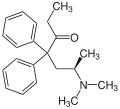Bürgi–Dunitz angle
Bürgi–Dunitz angle refers to a specific geometric angle observed in the approach of a nucleophile to a carbonyl group during a chemical reaction. This concept is named after Hans-Beat Bürgi and Jack D. Dunitz who first described it in the 1970s through crystallographic studies. The Bürgi–Dunitz angle is crucial in understanding the stereochemistry of nucleophilic addition reactions to carbonyl compounds, which are fundamental in organic chemistry and biochemistry.
Overview[edit]
The Bürgi–Dunitz angle is typically observed to be around 107°. This angle is measured between the approaching nucleophile and the normal to the plane formed by the carbonyl carbon and its attached oxygen. The significance of this angle lies in its consistent observation across a wide range of nucleophilic addition reactions to carbonyl groups, indicating a preferred trajectory for nucleophilic attack.
Chemical Significance[edit]
In the context of chemical reactions, the Bürgi–Dunitz angle provides insights into the mechanism of nucleophilic addition to carbonyl groups. Understanding this angle helps chemists predict and control the stereochemical outcomes of reactions. For instance, in asymmetric synthesis, manipulating the approach of the nucleophile can lead to the preferential formation of one enantiomer over another, which is of paramount importance in the pharmaceutical industry.
Biological Relevance[edit]
The concept of the Bürgi–Dunitz angle also finds relevance in biochemistry, particularly in the study of enzyme-catalyzed reactions involving carbonyl groups. Enzymes are known to precisely control the geometry of substrate binding and reaction pathways, often utilizing the principles underlying the Bürgi–Dunitz angle to achieve high specificity and efficiency in catalysis.
Research and Applications[edit]
Research into the Bürgi–Dunitz angle continues to be a vibrant area of study, with applications ranging from the design of new synthetic methodologies to the development of drugs and biomaterials. Advances in computational chemistry and molecular modeling have further enhanced our understanding of this geometric phenomenon, allowing for the exploration of its implications in complex chemical and biological systems.
See Also[edit]
External Links[edit]
-
Bürgi–Dunitz angle
-
Levomethadone structure
-
Protopine structure
-
Protopine 3D structure
-
Bürgi–Dunitz angle
-
Levomethadone structure
-
Protopine structure
-
Protopine from crystal structure
-
Bürgi–Dunitz angle 2D representation
-
Nucleophile HOMO and carbonyl LUMO overlap
Ad. Transform your life with W8MD's Budget GLP-1 injections from $75


W8MD offers a medical weight loss program to lose weight in Philadelphia. Our physician-supervised medical weight loss provides:
- Weight loss injections in NYC (generic and brand names):
- Zepbound / Mounjaro, Wegovy / Ozempic, Saxenda
- Most insurances accepted or discounted self-pay rates. We will obtain insurance prior authorizations if needed.
- Generic GLP1 weight loss injections from $75 for the starting dose.
- Also offer prescription weight loss medications including Phentermine, Qsymia, Diethylpropion, Contrave etc.
NYC weight loss doctor appointmentsNYC weight loss doctor appointments
Start your NYC weight loss journey today at our NYC medical weight loss and Philadelphia medical weight loss clinics.
- Call 718-946-5500 to lose weight in NYC or for medical weight loss in Philadelphia 215-676-2334.
- Tags:NYC medical weight loss, Philadelphia lose weight Zepbound NYC, Budget GLP1 weight loss injections, Wegovy Philadelphia, Wegovy NYC, Philadelphia medical weight loss, Brookly weight loss and Wegovy NYC
|
WikiMD's Wellness Encyclopedia |
| Let Food Be Thy Medicine Medicine Thy Food - Hippocrates |
Medical Disclaimer: WikiMD is not a substitute for professional medical advice. The information on WikiMD is provided as an information resource only, may be incorrect, outdated or misleading, and is not to be used or relied on for any diagnostic or treatment purposes. Please consult your health care provider before making any healthcare decisions or for guidance about a specific medical condition. WikiMD expressly disclaims responsibility, and shall have no liability, for any damages, loss, injury, or liability whatsoever suffered as a result of your reliance on the information contained in this site. By visiting this site you agree to the foregoing terms and conditions, which may from time to time be changed or supplemented by WikiMD. If you do not agree to the foregoing terms and conditions, you should not enter or use this site. See full disclaimer.
Credits:Most images are courtesy of Wikimedia commons, and templates, categories Wikipedia, licensed under CC BY SA or similar.
Translate this page: - East Asian
中文,
日本,
한국어,
South Asian
हिन्दी,
தமிழ்,
తెలుగు,
Urdu,
ಕನ್ನಡ,
Southeast Asian
Indonesian,
Vietnamese,
Thai,
မြန်မာဘာသာ,
বাংলা
European
español,
Deutsch,
français,
Greek,
português do Brasil,
polski,
română,
русский,
Nederlands,
norsk,
svenska,
suomi,
Italian
Middle Eastern & African
عربى,
Turkish,
Persian,
Hebrew,
Afrikaans,
isiZulu,
Kiswahili,
Other
Bulgarian,
Hungarian,
Czech,
Swedish,
മലയാളം,
मराठी,
ਪੰਜਾਬੀ,
ગુજરાતી,
Portuguese,
Ukrainian






